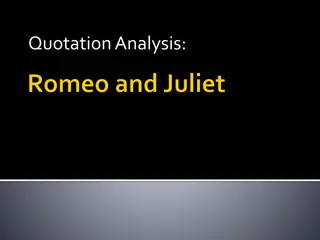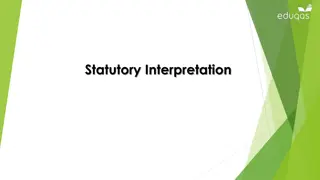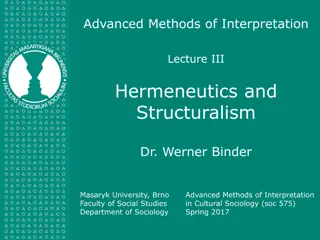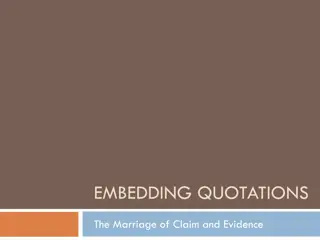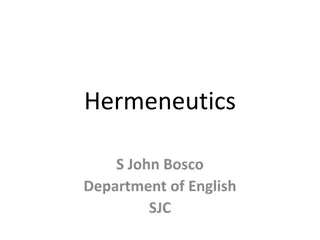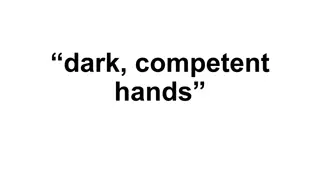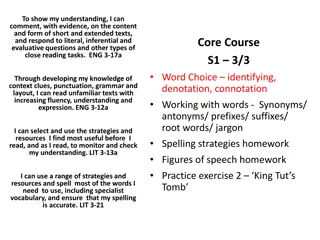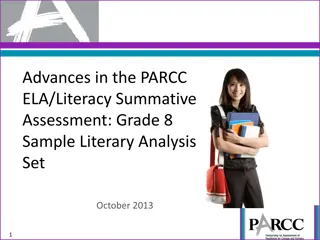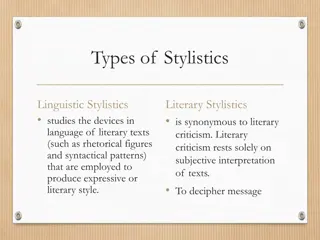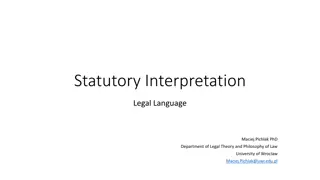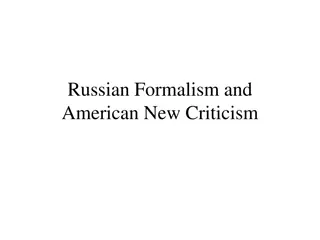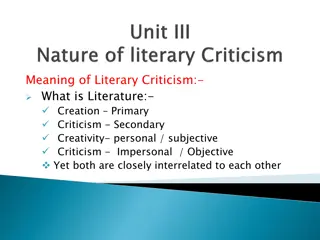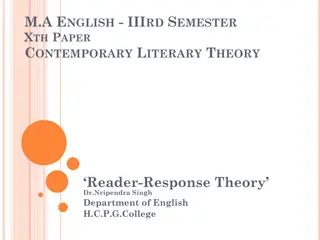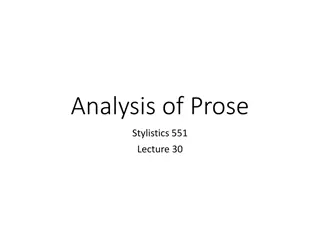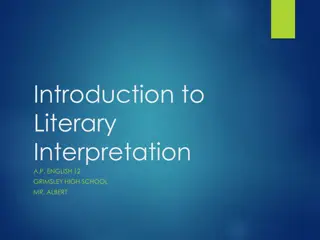Understanding Word Choice and Interpretation in Literary Analysis
Explore the nuances of word choice in literary analysis through examples and explanations in the context of positive childhood memories and disappointment, focusing on connotations, denotations, and personal interpretations.
Download Presentation

Please find below an Image/Link to download the presentation.
The content on the website is provided AS IS for your information and personal use only. It may not be sold, licensed, or shared on other websites without obtaining consent from the author. Download presentation by click this link. If you encounter any issues during the download, it is possible that the publisher has removed the file from their server.
E N D
Presentation Transcript
Resilience National 5 RUAE
1.Look at lines 1-7, and explain how one example of the writer s word choice makes it clear that his memories of childhood football are positive. 2
1.Look at lines 1-7, and explain how one example of the writer s word choice makes it clear that his memories of childhood football are positive. 2
Word Choice Questions 1. Highlight relevant examples of word choice 2. Quote 3. Comment on connotations 4. Link these back to the question
Denotation This is a word s meaning. This is not what you should comment on.
Connotation This is a word or phrase s associations. These are what you should focus on. Pre-natal mortality and baby deaths have the same meaning or denotation. However, the first has very medical, scientific connotations, suggesting categorisation and a lack of emotion. The latter has more emotive connotations.
Example Endlessly absorbing Has connotations of seeming to go on forever, but at the same time being captivating. This suggests that they enjoyed playing football so much that they never tired of it.
Look at lines 8-11, and explain in your own words why Mark was so disappointed. You should make four key points in your answer.
Look at lines 8-11, and explain in your own words why Mark was so disappointed. You should make four key points in your answer.
Explain- more information than identify questions. Usually you will need to articulate the relationship between different events or ideas. Own words- you must paraphrase rather than quote from the passage. Try to paraphrase chunks of meaning rather than individual words.
Answer He was never picked to play football for his school. Despite this, he didn t give up and attempted many times to get into the team. He was keen to develop as a player by being part of the team. He wanted the recognition that came with being part of the team.
Look at lines 12-25, and identify in your own words six points which the writer makes about young people hoping to become professional footballers.
Look at lines 12-25, and identify in your own words six points which the writer makes about young people hoping to become professional footballers.
Identify Use your own words Quite brief answers Use bullet points
Almost all of those signed at 16 do not become professional footballers This failure is very difficult for them to manage because they are young This can results in serious psychological problems They are discarded by the game they put so much into There are many more who do not even make it as far as being signed at 16 At every level the standard is higher and there are more and more rejections
Explain fully why the simile like grains of sand on a beach (line 29) is effective here.
Explain fully why the simile like grains of sand on a beach (line 29) is effective here.
Simile A comparison between two things that are similar but different. A simile is an example of imagery (a non-literal comparison) The poppies were as red as blood
Answering Imagery Questions Quote the image Explain what two things are being compared (deconstruct the image) Explain what they have in common and how this similarity helps to convey the writer s point. Use Just as . . . so too . . . for this part of your analysis.
Cavemen they may be Brooker uses a metaphor to compare the sexist presenters to cavemen. This is effective because a caveman is literally someone who existed in prehistoric times, which matches their outdated attitudes to females; just as cavemen have no place in the modern world, so too these sexist attitudes are outdated and unacceptable.
There are millions of others, like grains of sand on the beach, The players who fail to make it as professional footballers are being compared to grains of sand on a beach. This is effective because just as an overwhelming number try and fail to make it as footballers, so too a beach contains a vast, almost uncountable number of grains of sand. This, therefore, underlines the sheer scale of rejection that takes place.
Look at lines 31-35. By referring to two language features, explain how the writer makes clear his views about competition. You should refer to two different features such as word choice, imagery or sentence structure. (4)
Look at lines 31-35. By referring to two language features, explain how the writer makes clear his views about competition. You should refer to two different features such as word choice, imagery or sentence structure. (4)
Language features / use of language Highlight all the effective examples of word choice, imagery and sentence structure. Choose one that you find straightforward to explain Identify the feature Quote Analyse in the appropriate way
Sentence Structure This is life. The short sentence emphasises the writer s view that competition and failure are good things. The brevity creates a blunt statement that in reality not everyone can be a winner; not everyone can be the best. The blunt nature of the statement mirrors this harsh truth.
The writer tells us that football is a beautiful meritocracy. Explain in your own words three points the writer makes about merit being rewarded in the rest of this paragraph.
The writer tells us that football is a beautiful meritocracy. Explain in your own words three points the writer makes about merit being rewarded in the rest of this paragraph.
Some of the most successful footballers are from impoverished backgrounds. The vast number of failures indicates that many believe they could be successful as footballers. If someone is a good enough footballer, they will have a chance.
Look at lines 46-55, and identify, in your own words as far as possible, five points the writer makes in these lines about sport and / or life.
Look at lines 46-55, and identify, in your own words as far as possible, five points the writer makes in these lines about sport and / or life.
These who are confident and intellectually developed will often be superior athletes. There is a symbiotic relationship between athletic and intellectual development. This is understood far more in Europe. Failure is a component of our reality that we need to embrace. What matters more is our reaction to failure. While failing at sport can be disappointing, we can also allow it to redefine us.
Look at lines 56-59, and explain how one feature of the writer s sentence structure is used to highlight an important point.
Look at lines 56-59, and explain how one feature of the writer s sentence structure is used to highlight an important point.
Sentence Structure Highlight all the features of sentence structure that help to convey the writer s point. Quote one of these Identify the relevant features of sentence structure. Explain how they convey the writer s point (saying what this point is)
1. Length- particularly long or short? If so, why? 2. Use of punctuation for effect. Explain what the effect is. 3. Repetition. 4. Word order / inversion. 5. Use of climax or anticlimax. 6. Similar structure of one or more sentences in a paragraph.
It is an opportunity . . .called life. The list of opportunities (in the form of a tri colon) created by failure underlines the idea that failure can open our lives up to different possibilities. Within this list, the repetition of new reinforces the writer s point that failure, if responded to positively, creates fresh opportunities.
Select any expression in lines 60-64, and explain how it contributes to the passage s effective conclusion.
Effective Conclusion Links back to / sums up key ideas Links back to start (circular structure) Repeats an earlier phrase or image Provides a suitably strong sense of climax
To Answer Highlight all the phrases that help to create an effective conclusion. Quote one. Explain how it provides an effective conclusion by linking this to the rest of the passage, particularly key ideas.
We have to embrace it. This short, emphatic sentence creates an effective ending. It reinforces the passage s key idea: failure is an inescapable part of life; we must react positively to the opportunities that can come from it. One example of this is when failure is described as a pathway to a new reality.



